Innoxa (1930-1945)
Continued from: Innoxa
Continued onto: Innoxa (post 1945)
Despite the difficult economic conditions of the 1930s, Debat’s pharmaceutical and cosmetic empire continued to expand. The laboratories and manufacturing facilities at Garches were updated and expanded in 1933, with housing and other facilities developed through to the outbreak of the Second World War. Products produced at Garches continued to be advertise in Debat’s magazine ‘Art et Médecine’.
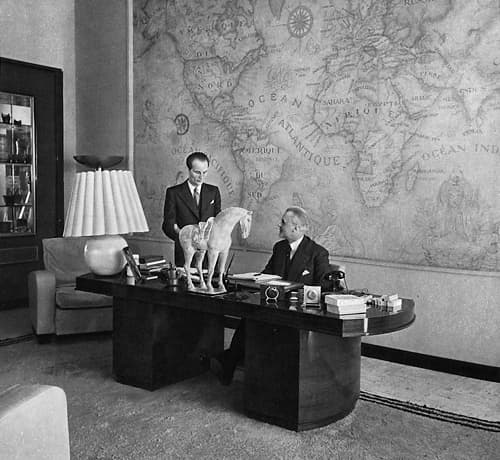
Above: 1937 Dr. François Debat in his office.
The Innoxa range was also widened to include a complete line of make-up. Exactly when this happened is unknown to me but the most likely date is 1930. Information on the activities of the French company regarding this and other developments are scarce so I will concentrate on the British company and its affiliates which is better documented.
Innoxa (England) Ltd.
In 1931, Innoxa (England) began manufacturing Innoxa products in England in new packaging which allowed it service the home market but also to send Innoxa cosmetics to British dominions. In 1933, exports from England began to Australia, New Zealand and South Africa followed by India, British Malaya and other parts of the British Empire. The line would prove to be particularly popular in Australasia.
Exports to the dominions included skin-care products and make-up bas well as perfumes – Dream Garden, Marguerite, Narcissus, Inspiration, Gardenia, and Fleur des Bois.
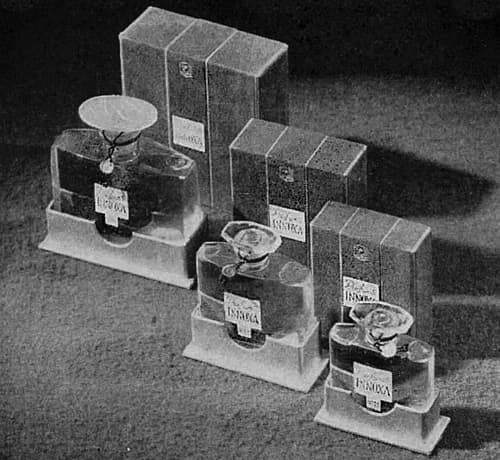
Above: 1930 Parfums Innoxa (UK).
Skin-care
New skin-care cosmetics added in Britain through to 1933 included: Innoxa Complexion Vitaliser, an astringent lotion applied with a brush; and Innoxa Muscle Oil.
Innoxa Complexion Vitaliser: “Penetrating deep into the pores, it disperses blackheads and other blemishes, and by establishing a normal condition of the skin, eliminates all tendency to oiliness caused by excessive activity of the sebaceous glands.”
Innoxa Muscle Oil: “By penetrating deeply into the skin. it maintains the youthful elasticity of the facial muscles, thus correcting any tendency to the sagging, lined appearance so suggestive of advancing years.”
See also: Muscle Oils
When combined with earlier Innoxa products this meant that Innoxa (England) now had skin-care regimes equivalent to most of its contemporaries.

Above: 1937 Complexion Milk, the basis of all Innoxa skin-care regimes (UK).
Normal Skins
Morning: Sponge the face with tepid water, cleanse with Innoxa Complexion Milk, wipe off with cotton-wool, apply Innoxa Skin Tonic. Finish with Innoxa Matine Cream, or, If preferred, Mousse, and then powder.
Evening: Before retiring, cleanse face with Innoxa Complexion Milk, gently wipe off with cotton-wool. Twice a week pat In Innoxa Skin Food and clean off with cotton-wool moistened with Skin Tonic.Greasy Skins
Morning: Sponge the face with hot water to which has been added a tablespoonful of Borax to every quart; cleanse with Innoxa Complexion Milk, wipe off with cotton-wool moistened with Innoxa Astringent Lotion, dry, and then apply Innoxa Foundation Lotion, or, if preferred, Innoxa Matine Cream. Finish with Innoxa Powder. The Innoxa Facial Pack should be used once a week.
Evening: Before retiring, cleanse with Innoxa Complexion Milk, and when thoroughly dry apply Innoxa Complexion Vitaliser, allowing it to disappear entirely of its own account by belng completely absorbed by the pores of the skin: discontinue when the skin becomes dry.Dry Skins
Morning: Sponge the face with tepid water, cleanse with Innoxa Complexion Milk, wipe off with cotton-wool; when dry apply Innoxa Mousse Day Cream and Powder.
Evening: Before retiring, cleanse with Innoxa Complexion Milk, gently wipe off with cotton-wool. Then mould Innoxa Skin Food into the skin, using the fingers with firm upward strokes, Leave a little on the skin to be absorbed during the night.(‘Beauty by culture,’ c.1933, p. 7)

Above: 1936 Advertorial in French Vogue featuring Mousee Innoxa au Lys Bleu and Lait Innoxa. The dove featured strongly in Innoxa advertising of the period as a symbol of purity.
In 1937, Innoxa (England) added Innoxa Tissue Cream and Innoxa Cleansing Cream. The Tissue Cream was a skin food for dry or sensitive skins while the Cleansing Cream was a substitute for the Cleansing Milk.
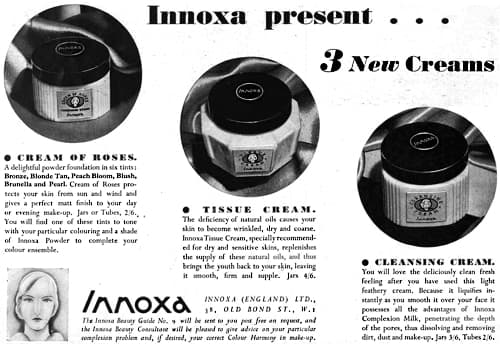
Above: 1930 Innoxa Cream of Roses, Tissue Cream, and Cleansing Cream.
Tissue Cream: “[S]pecially recommended for dry and sensitive skins, replenishes the supply of natural oils, and thus brings the youth back to your skin, leaving it smooth, firm and supple.”
Cleansing Cream: “Because it liquifies instantly as you smooth it over your face it … [penetrates] the depth of the pores, thus dissolving and removing dirt, dust and make-up.”
In 1937, Innoxa (France) introduced Crème Organique Innoxa containing hormones and vitamins A and F, released in Britain as Vitormone Cream.
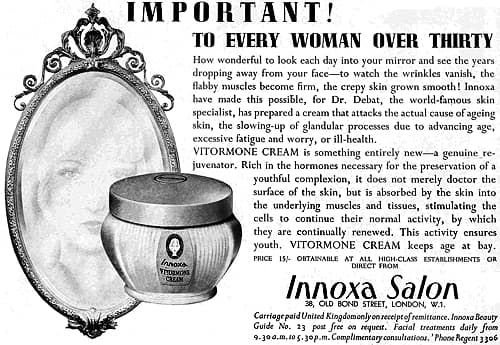
Above: 1937 Innoxa Vitormone Cream (UK).
The French company also put vitamins into a lipstick in Framboise, Cerise, Coquelicot, Mandarine, and Tangara shades. Although it seems likely, I have no evidence that the British company followed suit.
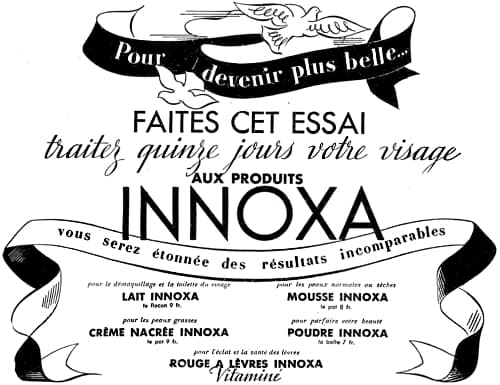
Above: 1938 Lait Innoxa, Crème Nacrée Innoxa, Mousse Innoxa, Poudre Innoxa, and Rouge a Lèvres Innoxa Vitaminé.
Vitormone Cream was created as a night cream but it could also be used as a powder base during the day.
1. Clean your skin at night and morning with cool deep-cleansing Innoxa Complexion Milk. It floats away impurities, restores the natural oils, and leaves your skin soft and supple.
2. Next apply Innoxa Vitormone Cream over your face and neck. Leave it on all night.
3. The following night and on alternate nights, feed your skin with rich, nourishing Innoxa Tissue Cream.
4. In the morning after cleansing, use Vitormone Cream as your powder base. It is a wonderful foundation cream and while keeping your powder beautifully matt all day goes on nourishing and tending your skin.(Innoxa communication, 1953)
Innoxa (England) sold Vitormone Cream in two forms – Vitormone M for dry skins and Vitormone G for oily skin types. A double strength version containing Vitamins A, D, and F was added by 1940.
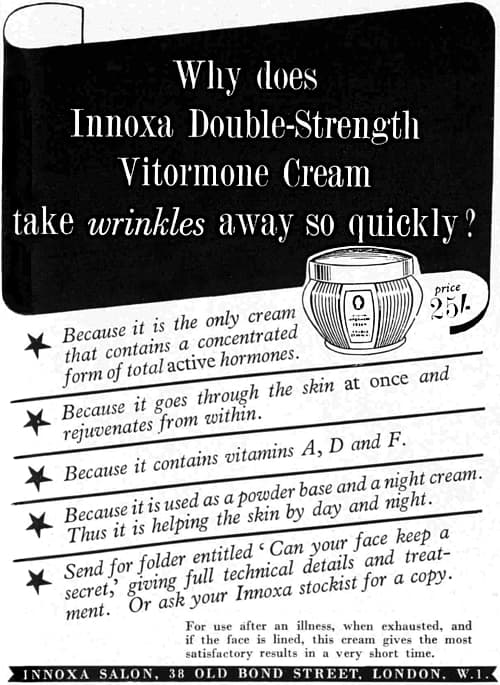
Above: 1940 Innoxa Double Strength Vitormone Cream (UK).
See also: Hormone Creams, Oils and Serums
In 1939, Innoxa (France) introduced Solution 39, a treatment for blackheads, open pores, spots, blemishes and oily skin conditions. It appears to have contained salicylic acid – a beta-hydroxy acid (BHA) – a chemical exfoliant still used today to unblock pores and smooth blemished skin.
Make-up
The earliest reference I have for Innoxa make-up, apart from Innoxa Powder, comes from Britain in 1930. However, until the British factory was built in 1932, these make-up items must have come from France.
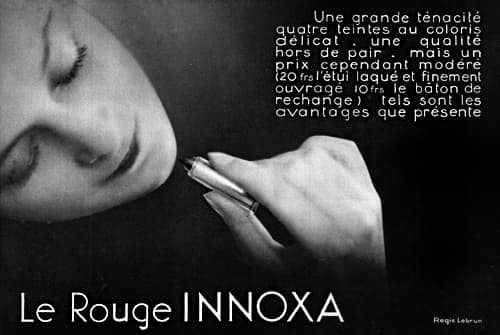
Above: 1933 Le Rouge Innoxa.
Initially, the make-up range in Britain was sold as Innoxa Beautica but this was dropped by the end of 1931. The British Beautica range included Beauticia Ruby Cream (rouge), Beautica Lip Rouge (lipstick) in a refillable case, and Beauticia Cosmetique (cake mascara). Beautica Ruby Cream and Lip Rouge were both available in Clair, Electric, and Foncé shades, with Mandarin added in 1933, and Dawn and Autumn shades introduced in 1937.
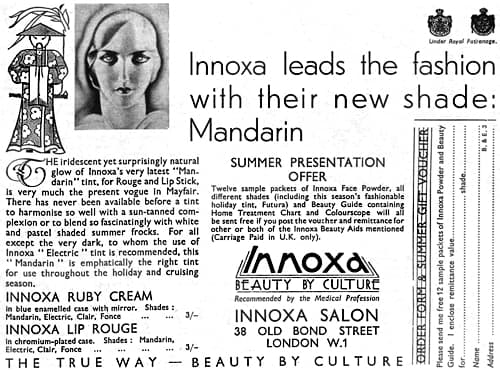
Above: 1933 Innoxa Mandarin (UK).
Beauticia Ruby Cream: “Gives a natural delicate colouring.”
Beauticia Lip Rouge: “Indelible, non-greasy and waterproof. Spreads evenly and easily.”
Beauticia Cosmetique: “For beautifying the eyelashes and eyebrows, In velour case with mirror and brush.”
Lipsticks
Innoxa lipsticks underwent some changes in Britain during the 1930s. The Mayfair case was introduced in 1937 along with the new Dawn and Autumn shades but was reformulated and repackaged again in 1939 coming in four additional shades – New Petunia, Anemone, Cardinal, and Mayflower – in a silver-banded case.
Powder and foundation
By 1930 at the latest, Innoxa Face Powder was available in two forms with Powder No. 2 being more suited to dry and sensitive skins. Both powders were available in 10 shades by then – Peach, Pearl, Naturelle, Rachel, Rachel-Clair, Blanche, Rose-Thé, Corail, Ocre, and Chair. Later shade additions included: Green, and Futura (1932); Aprella, and Pereena (1933); and Beachtan, and Blush (1938). Some shades were also dropped. For example, Ocre and Green were discontinued in 1934, replaced with Olivette.
To help the powder adhere to the skin a face cream was first applied. Innoxa Cold Cream or Innoxa Mousse were recommended as a powder base but if something lighter was preferred Innoxa Cleansing Milk could also be used.
Innoxa Cold Cream seems to have been discontinued in Britain in the 1930s leaving women with the choice of Innoxa Mouse or Innoxa Matine Cream, the later debuting in Britain around 1932. Innoxa Mousse was recommended for dry skin types while Innoxa Matine was suggested for women with oily skin. The only product in the French line that might be equivalent to Matine Cream is Créme Nacrée Innoxa but this did not appear in France until 1937.
Innoxa Matine Cream: “[W]ill be welcomed by all whose skin is inclined to be greasy. … It imparts a matt, velvety appearance to the complexion and serves as an ideal foundation.”
By 1932, Innoxa (England) had also introduced Foundation Lotion, tinted in the same shades as Innoxa Face Powder. A second tinted foundation, Cream of Roses followed in 1937.
Foundation Lotion: “Fluid powder base, ideal for hands, neck and arms in the evening. For the face, too, when an extra-matt surface is desired. It goes on with beautiful ease—none of the skin-stretching operations necessary with stiffer creams.” Shades: Rachel, Peach, Pearl, Futura, Naturelle, and Sunbronze with additional shades added to match Innoxa Face Powders as these were introduced.
Cream of Roses: “[P]rotects your skin from sun and wind and gives a perfect matt finish to your day or evening make-up.” Shades: Bronze, Blonde Tan, Peach Bloom, Blush, Brunella, and Pearl.
Eye products
Eye make-up in Britain included: Innoxa Cosmetique, a block/cake mascara in a velour case with mirror and brush; Innoxa Eye Shadow in Light Blue, Blue, Green, Brown, and Mauve shades; and Eyebrow Pencils in Light Brown, Brown and Black. Like many other cosmetic companies of the time, Innoxa also sold an Eyelash Grower, and Innoxa Eye Lotion to treat eye strain, a precursor to the later Gouttes Bleues.
Colourscope
Like her dress, Innoxa make-up was to be selected so that it was in harmony with a woman’s natural colouring.
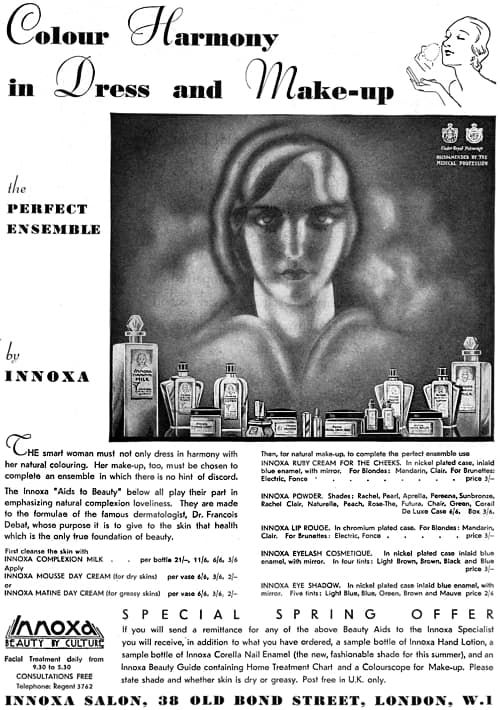
Above: 1934 Colour harmony in dress and make-up.
To help women select the appropriate shade of make-up Innoxa (England) produce Colourscopes which matched Innoxa powder, rouge, lipstick and eye make-up with a women’s hair, eyes and complexion.
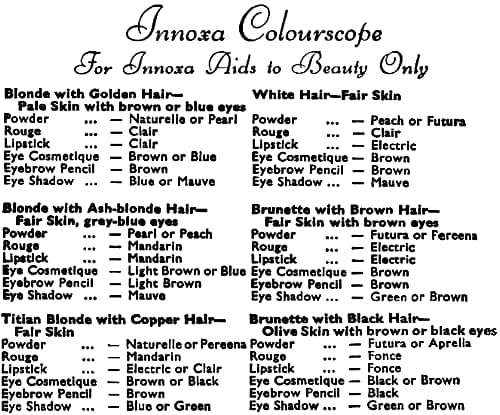
Above: c.1933 Innoxa Colourscope.
Hands and Nails
Products for the hands sold by Innoxa (England) included a hand cream, cuticle cream, cuticle remover, nail enamel and enamel remover. The nail enamel appears to have been translucent and was only applied to the pink part of the nail leaving the half moon and free edge clear, suggesting it was not an opaque polish of the type that would come to dominate by the end of the 1930s.
Liquid Nail Enamel: “[B]eautifies the nails with rich kustre. It will not crack, peel or discolour.” Shades: Naturelle, Rose, Rose Foncé, and Rouge Nacré, with Corella added in 1933.
See also: Nail Polishes/Enamels

Above: 1935 Dr. François Debat and his wife, Marie Debat.
War
By the end of the decade Laboratoires Debat was exporting its products around the world.
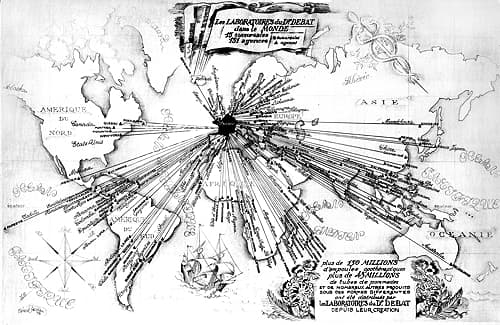
Above: 1938 Export map for Laboratoires Debat.
Debat was honoured for his services to science, and to French exports, by having his image used on the reverse side of a new 20 Franc note.

Above: Reverse side of a 20 Franc note depicting Debat, first released December, 1939.
This all came to an abrupt halt when the German invasion of France cut Laboratoires Debat and Innoxa (France) off from most of their markets and subsidiaries and curtailed manufacturing in France. Debat was not personally affected by the German occupation but the building program at Garches was suspended.
Innoxa (England) was also badly affected by the war. In late 1940, the salon at 38 Old Bond Street was destroyed by German bombing and salon treatments were suspended for the remainder of the war. As Britain was largely cut off from the rest of the world it was unable to send new stocks to the United States and sales there stopped. Somehow or other, Australia managed to continue selling Innoxa products and treatments through the war although many items became scarce or unavailable.
Despite the difficulties, Innoxa (England) managed to introduce some new products during the war. these included: Innoxa Tan, a sun protectant; Innoxa Lotion 41; and Innoxa White Mask, a mild facial bleach.
Innoxa Tan: “[P]romotes Tan without burning. Soothes already burnt skin.”
Lotion 41: “A simple home treatment works wonders on acne, blackheads and allied skin ailments. … [A]cts as a fat solvent and normalises the fat glands. Pat in night and morning and leave on under your ordinary make-up.”
White Mask: “It’s a glorious tonic, which goes on like a cream, acts instantly, and, most important of all, contains vitamin D—the sunshine vitamin.”
I assume Innoxa Lotion 41 was the British version of Innoxa 39. It was available in Britain by 1940. Innoxa Tan also seems to have had a French precursor in the form of L’Hiver Innoxa pour brunir, introduced in France no later than 1938.
Timeline
| 1932 | London factory established Innoxa (England) Ltd. founded. New Products: Foundation Lotion (UK). |
| 1937 | New Products: Crème Nacrée; (France); Crème Organique (France), Vitormone (UK); and Cream of Roses (UK). |
| 1938 | New Products: Huile Pour Brunir (France). |
| 1939 | Scientific Pharmacals Ltd. founded (UK). New Products: Solution 39 (France). |
| 1940 | New Products: Innoxa Tan (UK). |
Continued onto: Innoxa (post 1945)
First Posted: 30th May 2021
Sources
The American Perfumer & Essential Oil Review. (1906-1955). New York: Robbins Perfumer Co. [etc.].
The chemist and druggist. (1859-) London: Morgan Brothers.
François Debat de l’industrie à l’Académie des Beaux-Arts Angoulême. [n.d.] Retrieved April 30, 2021, from https://www.aaiiphp.org/uploaded/debat.pdf
The house of Innoxa: Past, present and prospects for the future. (1962). Soaps, perfumery & cosmetics. August, 716-720.

1941 Dr. François Debat [1882-1956]
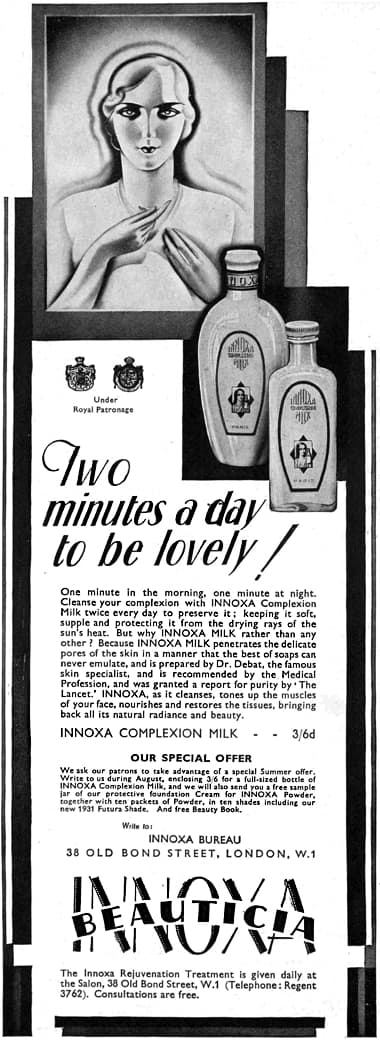
1931 Innoxa Beautica (UK).

1932 Innoxa Lipstick (France).
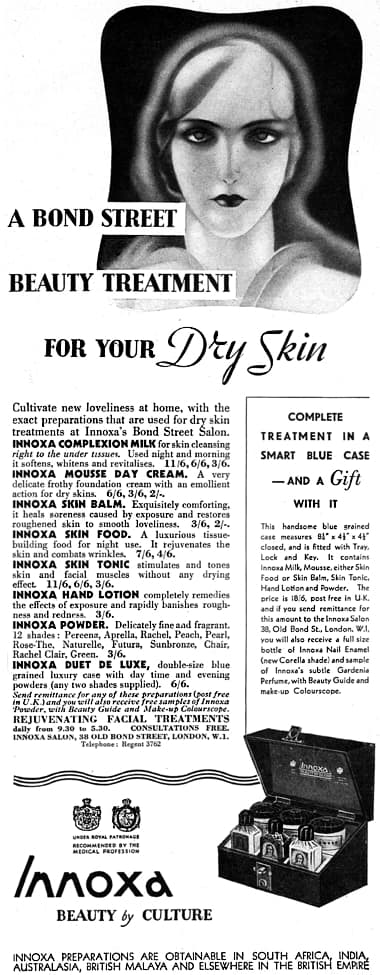
1934 Innoxa Dry Skin Treatment (UK).
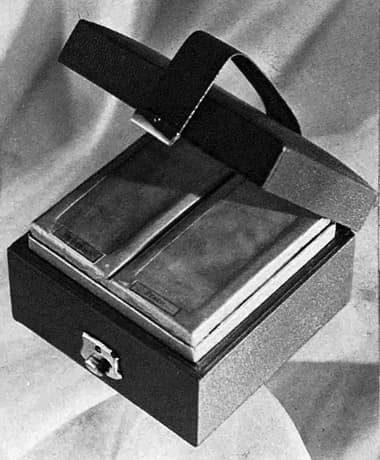
1934 Innoxa Duet (UK). These double powder boxes held one powder for day and one for night.
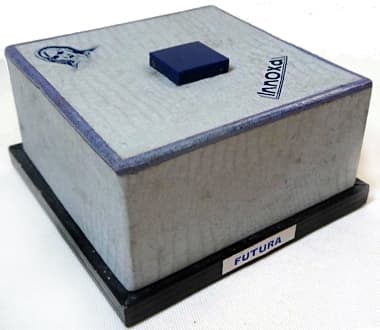
c.1935 Innoxa Futura Face Powder (UK).

1936 Parfums Innoxa (Australia).
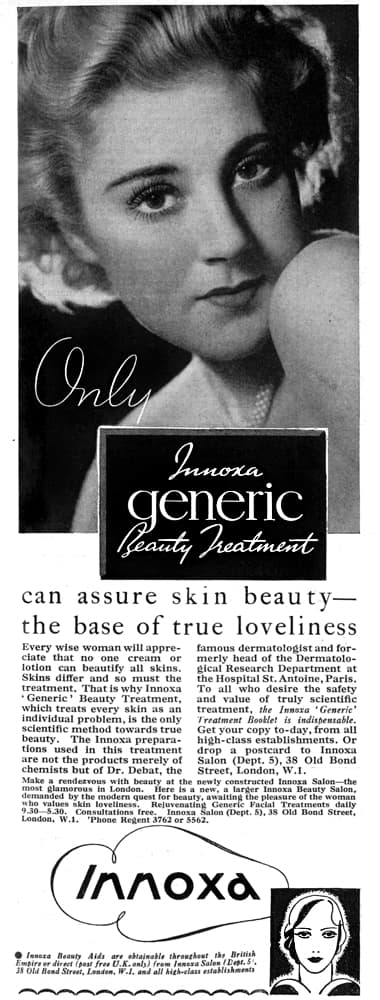
1936 Innoxa Rejuvenating Generic (Individual) Facial Treatments (UK).
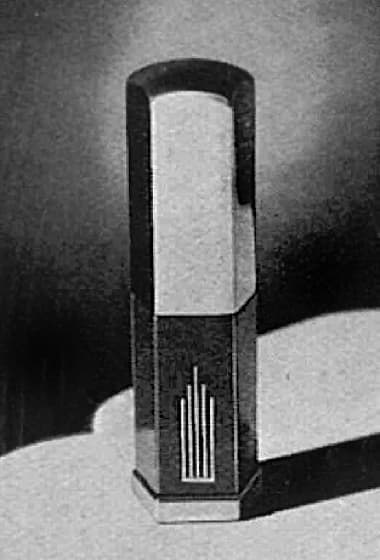
1937 Innoxa Mayfair Lipstick (UK).
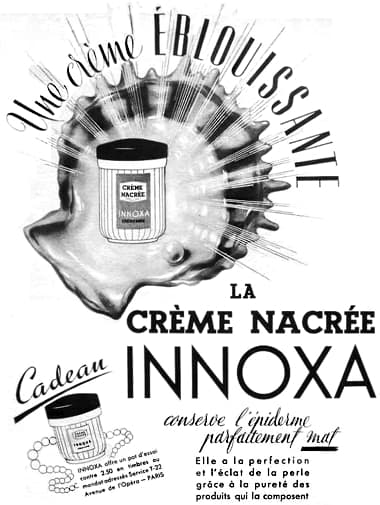
1937 Crème Nacrée Innoxa.
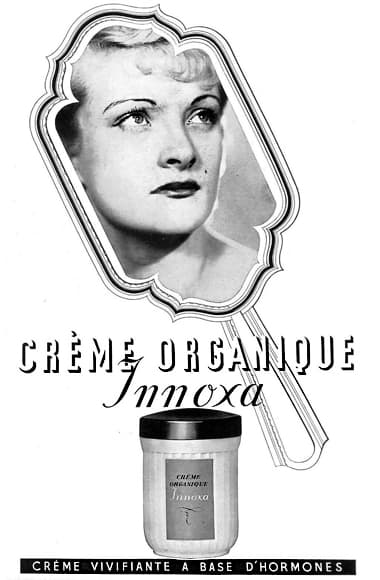
1937 Crème Organique Innoxa.
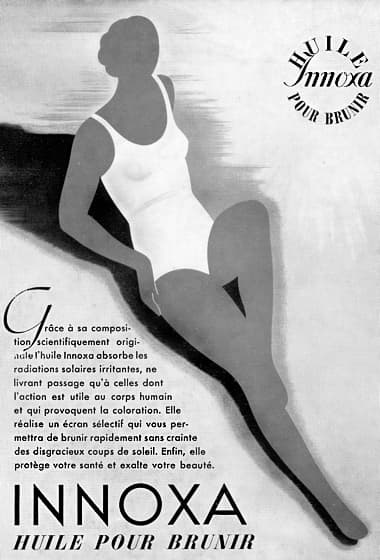
1938 Innoxa Huile Pour Brunir.
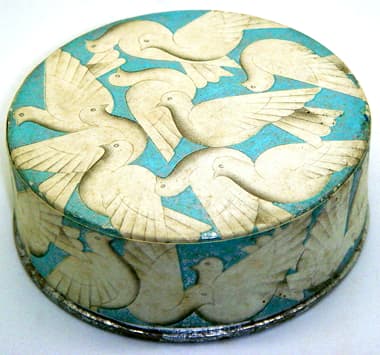
c.1938 Innoxa Powder Box (France).
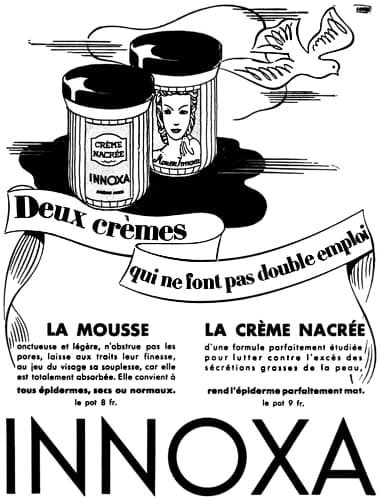
1938 Mousee Innoxa and Crème Nacrée Innoxa.
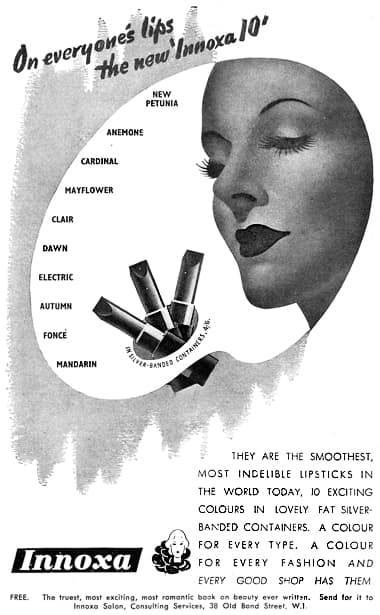
1939 Innoxa Lipstick (UK).
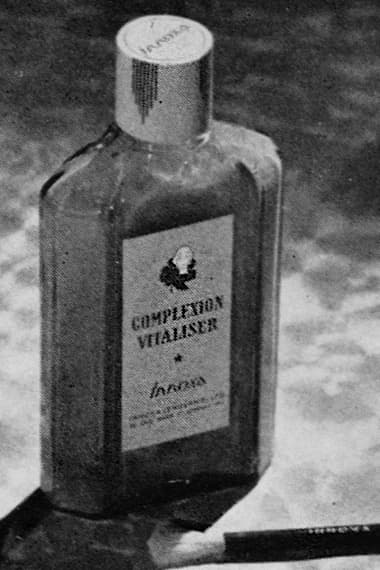
1939 Innoxa Complexion Vitaliser with brush (UK).
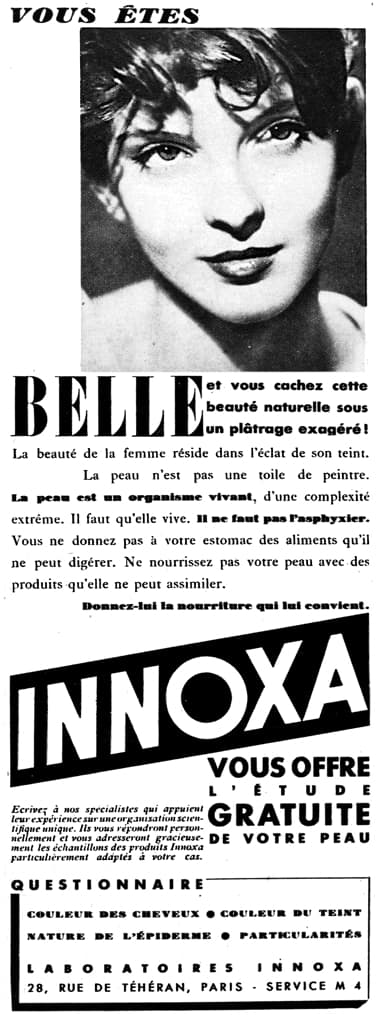
1939 Innoxa France temporarily based at 28 Rue de Téhéran, Paris.
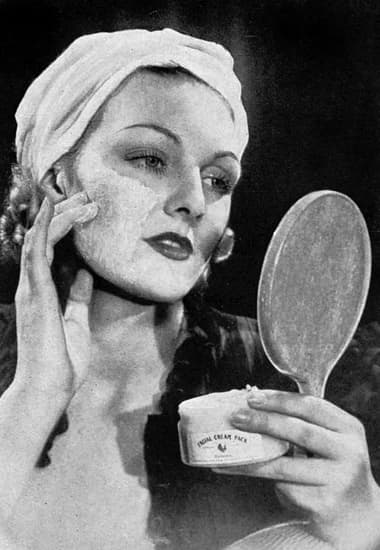
1939 Applying Innoxa Cream Pack (UK).
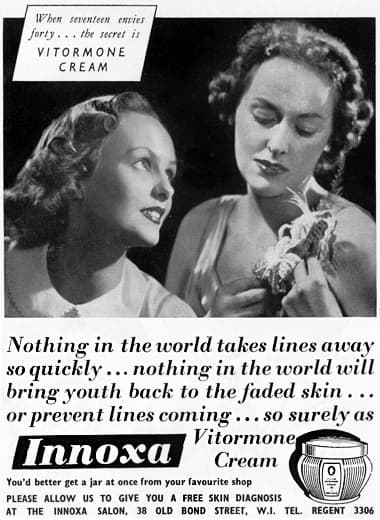
1939 Innoxa Vitormone (UK).
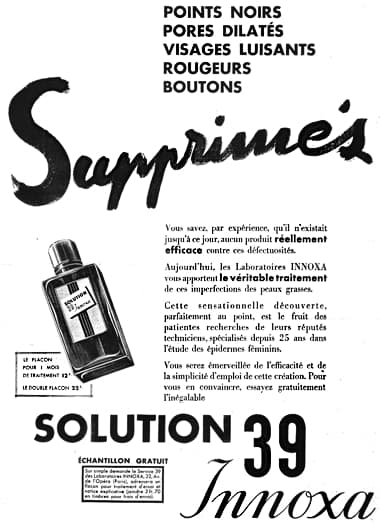
1939 Innoxa Solution 39.
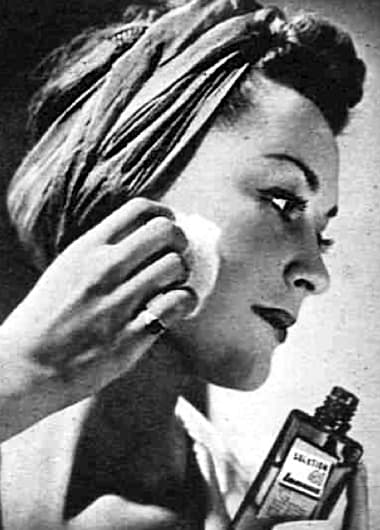
1940 Applying Innoxa Lotion 41 (UK).
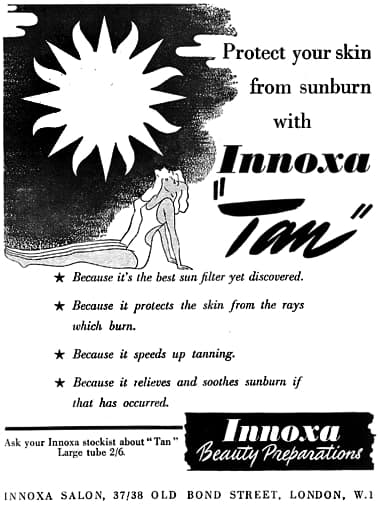
1940 Innoxa Tan (UK).
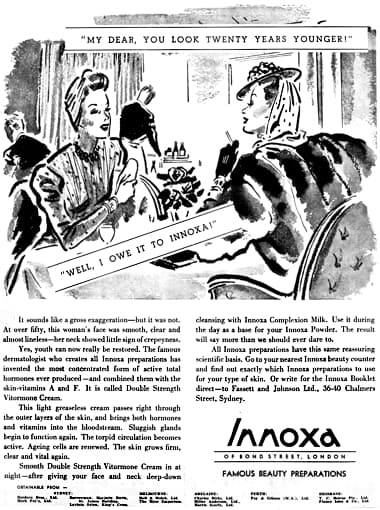
1941 Innoxa (Australia).
